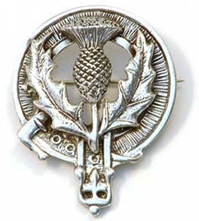|
William,
fifth Earl of Seaforth, having engaged in the
rebellion of 1715, was afterwards included in
the acts of attainder, and forfeited his title
and estate. His eldest son, however, became a
zealous advocate for the Protestant succession,
and supported the government during the
rebellion in 1745; his grandson, Kenneth
Mackenzie, was permitted to re-purchase the
estate from the Crown, and was created an Irish
peer, in 1766, by the title of Baron Ardeloe, in
the county of Wicklow, and Ariscount Fortrose,
in Scotland, and in 1771, he was advanced to the
dignity of Earl of Seaforth, which had been long
enjoyed by his ancestors.
The American war
commenced in 1775, and the Earl of Seaforth,
in gratitude for the favors he had received,
made an offer to His Majesty, to raise a
regiment of foot on his estate, which, in
former times, had been able to furnish a
thousand men in arms. This offer was
accepted in December, 1777; the Earl of
Seaforth received a letter of service to
raise a regiment of foot, of which he was
appointed Lieut.- Colonel Commandant. The
regiment was known as the 78th
Highland Regiment or Seaforth’s Highlanders.
The men were
principally raised from the clan of
“Caber Feidh” as the Mackenzie’s were
called from the stag’s horns on the armorial
bearings of Seaforth. Five hundred men were
from the Earl of Seaforth’s own estates, and
about four hundred from the estates of the
Mackenzies of Scatwell, Kilcoy, Applecross,
and Redcastle, all of whom had sons or
brothers holding commissions in the
regiment: the officers from the Lowlands
brought upwards of two hundred, of whom
seventy-four were English and Irish.
The original Mackenzie
regiment had had its number previously
reduced to 72nd Regiment of Foot. On 10
February 1794 the government agreed to his
proposal to raise a second battalion, the
Ross-shire Buffs. The two battalions were
amalgamated in 1796. Another battalion was
raised in 1804 (letter of service dated 17
April) and these were again amalgamated July
1817.
In 1798 he was
appointed Colonel of the Ross-shire Regiment
of Militia. In 1808 he was made a
Lieutenant-General.
In 1794 he was
elected a Fellow of the Royal Society. He
was appointed Lord Lieutenant of Ross and
was raised to the peerage of the United
Kingdom as Lord Seaforth and Baron Mackenzie
of Kintail on 26 October 1797. He was
Governor of Barbados from 1800-06, during
which period he ended slavery and slave
killing on the island, after which he held
high office in Demerera and Berbice.
|



